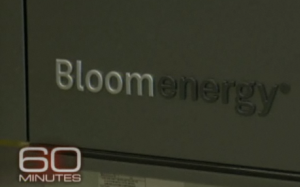
According to a preview of the episode on CBS News’ web site, Bloom has already recruited a prestigious roster of 20 early customers, including Google, Wal-Mart, eBay, and none other than the CIA. Some of them already have the fuel cells, which retail for between $700,000 and $800,000, installed. More information is sure to be revealed on the show, and again during a company-hosted press conference next week.
[aditude-amp id="flyingcarpet" targeting='{"env":"staging","page_type":"article","post_id":162105,"post_type":"story","post_chan":"none","tags":null,"ai":false,"category":"none","all_categories":"business,enterprise,","session":"C"}']Bloom has done an impressive job of keeping its technology under wraps until now — even through several fund raises, a public estimation of its valuation at $1.45 billion, and the launch of indirect competitor ClearEdge Power (a company that may find itself in hot water if Bloom dazzles viewers as expected on Sunday).
ClearEdge is a bit different, focusing on $50,000 fuel-cell generators suited to powering individual households and depending solely on natural gas. But it may only have a few years’ head start in this arena. Bloom has already expressed its intention to develop a box for the home market that could cost as little as $3,000 in the next five to 10 years, as Earth2Tech also points out.
AI Weekly
The must-read newsletter for AI and Big Data industry written by Khari Johnson, Kyle Wiggers, and Seth Colaner.
Included with VentureBeat Insider and VentureBeat VIP memberships.
The company fully expects to become a multi-billion dollar business in the next five years. It expects the bulk of its revenue to come from sales and lease agreements but hasn’t ruled out the possibility of launching a subsidiary to broker power-purchase agreements with utilities and other clients.
Here’s what we know about its actual technology: the Bloom Box is based largely on a solid-oxide fuel cell (that can run on biomass or natural gas) developed by scientists at NASA and is made out of cheaper materials than those built by its competitors (at least according to company PR). The device is also said to withstand a wider range of temperatures, making it suitable for a wide array of applications (even the space shuttle).
Analysts believe the box could reduce carbon footprints by 50 to 100 percent (depending on the feedstock used — whether it’s switchgrass, corn husks or natural gas). The preview of the 60 Minutes episode also quotes eBay CEO John Donahoe as saying that five Bloom Boxes have already saved the auction site $100,000 in energy costs.
When it comes to other bits and pieces of Bloom news, Greentech Media seems to have the inside track, so instead of listing what they’ve found, I’ll link you to a comprehensive roundup of findings on their site here.
The company last raised funding in March 2009, bringing in $17 million of what it hoped at that time would be a $200 million private equity offering. It has the distinction of being Kleiner Perkins Caufield & Byers’ first green investment. Tune in on Sunday at 7 p.m. to see if all the hype is deserved.
Here’s the video preview via CBS News:
[aditude-amp id="medium1" targeting='{"env":"staging","page_type":"article","post_id":162105,"post_type":"story","post_chan":"none","tags":null,"ai":false,"category":"none","all_categories":"business,enterprise,","session":"C"}']
http://cnettv.cnet.com/av/video/cbsnews/atlantis2/player-dest.swf
Watch CBS News Videos Online
VentureBeat's mission is to be a digital town square for technical decision-makers to gain knowledge about transformative enterprise technology and transact. Learn More
